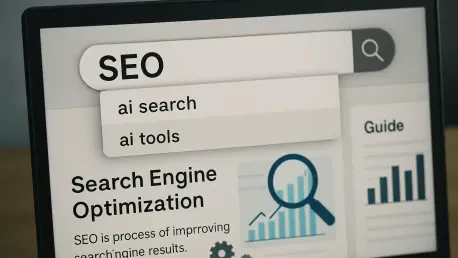In an era where digital landscapes are constantly evolving, a staggering shift has emerged as Google redefines its role in the search engine domain by seamlessly integrating advertisements into AI-generated search answers across the globe, marking a bold departure from its traditional function. This strategy transforms Google from a mere conduit linking users to external content into a content creator and publisher in its own right. By embedding ads directly within AI-driven responses, Google is not only enhancing the user experience with personalized and contextual advertising but also reshaping the digital advertising ecosystem. This development raises critical questions about the balance between innovation and market dominance, as well as the broader implications for external publishers and the open web. As this transformation unfolds, understanding the mechanisms behind this integration and its far-reaching effects becomes essential for stakeholders across the tech and media industries.
Redefining Search with AI-Driven Advertising
The integration of ads into AI-generated search answers represents a pivotal moment in Google’s evolution, showcasing how advanced technology can blend information delivery with commercial intent. With the rollout of tools like AI Max, currently in beta worldwide, advertisers can now place contextual ads within detailed, narrative-style responses through platforms such as Google Ads and Search Ads 360. This approach capitalizes on the growing trend of conversational search queries, where over 60 percent of shopping-related searches use broad, natural language. For example, a query about fixing low water pressure might yield an AI-crafted solution accompanied by targeted ads for local plumbing services. This seamless fusion not only enhances relevance for users but also creates a new revenue stream for Google, potentially increasing ad margins if these formats outperform traditional link-based advertisements. The shift underscores a strategic move to keep users within Google’s ecosystem, reducing reliance on external links.
Beyond the technical innovation, this strategy signals a broader transformation of Google into what some industry observers describe as an “omni-publisher.” By generating and controlling content through AI, Google is no longer just a gatekeeper directing traffic to other sites but a primary source of information itself. This change has profound implications for how users interact with search results, as the focus shifts from browsing multiple websites to receiving comprehensive answers directly on the platform. While this can streamline the search process, it also raises concerns about the diversity of information available to users, as Google’s algorithms prioritize its own content and ads over external sources. The potential for paid links or sponsored snippets within these answers looms on the horizon, reminiscent of early monetization strategies that scaled massively over time. As this model develops, the balance between user value and commercial interests will remain a critical point of discussion in the digital space.
Impact on Publishers and the Digital Ecosystem
As Google embeds ads into AI search answers, the ripple effects on external publishers and media companies are becoming increasingly apparent, often to their detriment. With users receiving detailed responses directly on the search platform, traffic to independent websites has started to decline, eroding both audience reach and ad revenue for these entities. This shift is particularly challenging for smaller publishers who rely heavily on search engine referrals to sustain their operations. Google’s growing control over content delivery means that its AI-generated answers, paired with strategically placed ads, can capture user attention before they even consider clicking through to external sources. This dynamic threatens the financial viability of many online content creators, potentially shrinking the diversity of voices in the digital landscape as larger players struggle to compete with Google’s integrated approach.
Moreover, this trend amplifies Google’s dominance in the digital advertising market, creating a challenging environment for competitors and independent media alike. By prioritizing its own content and ad placements, Google not only enhances its revenue potential but also reshapes the competitive landscape in its favor. The concern here is not just about immediate revenue loss for publishers but the long-term implications for the open web, where access to varied perspectives could diminish. Industry analysts suggest that this is merely the beginning, with potential expansions into more aggressive monetization tactics within AI responses over the coming years. As Google continues to refine this model, external stakeholders face the daunting task of adapting to a reality where their visibility and economic sustainability are increasingly dictated by a single tech giant’s algorithms and business priorities, prompting calls for strategic innovations or partnerships to counterbalance this shift.
Regulatory Challenges and Market Fairness
Amidst Google’s integration of ads into AI search answers, regulatory scrutiny has intensified, highlighting tensions over market fairness and competitive balance. Authorities in the United States are actively challenging Google’s expanding control over digital advertising and content, with legal actions underway to potentially dismantle parts of its ad tech operations. Critics argue that this dual role as both a content provider and advertising powerhouse undermines the principles of an open web, where diverse players should have equal opportunities to thrive. Google’s defense—that fragmenting its ad business could accelerate the decline of external platforms—carries a tone of caution, yet many see its actions as directly contributing to the marginalization of third-party publishers. This legal battle underscores broader concerns about whether innovation should come at the cost of competition.
Additionally, the regulatory landscape reflects a growing unease about Google’s ability to shape user behavior through AI-driven content and advertising. The seamless embedding of ads within search answers, while user-friendly, raises questions about transparency and the potential for undue influence over consumer choices. As Google leverages its vast data resources to personalize these ads, regulators are tasked with determining whether such practices align with fair market standards or if they tilt the playing field too heavily in Google’s favor. The outcome of these legal challenges could set significant precedents for how tech giants operate in the digital advertising space over the next few years, from the current point through to future milestones. For now, the tension between fostering technological advancement and ensuring a competitive digital environment remains a central issue, with implications that could reshape industry norms and policies globally.
Navigating the Future of Digital Advertising
Reflecting on Google’s journey to embed ads within AI search answers, it becomes clear that this initiative redefines the boundaries of search technology and digital commerce. The strategic use of AI Max and other tools to deliver contextual advertising alongside comprehensive responses marks a turning point in how users engage with search platforms. This move, while innovative, also spotlights the vulnerabilities of external publishers who grapple with diminished traffic and revenue as Google’s ecosystem expands. Regulatory battles further illuminate the complexities of balancing market dominance with fair competition, leaving lasting impressions on the industry’s trajectory.
Looking ahead, stakeholders must consider adaptive strategies to navigate this transformed landscape, such as exploring alternative platforms or advocating for policies that safeguard diversity in digital content. Collaborative efforts between publishers and tech innovators could foster new models that prioritize equitable revenue sharing. Meanwhile, regulators might focus on frameworks that ensure transparency in AI-driven advertising practices. As the digital advertising realm continues to evolve, proactive steps toward balancing innovation with inclusivity will be vital for sustaining a vibrant, competitive online ecosystem.









